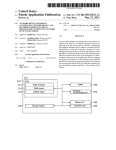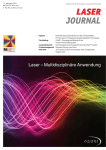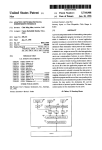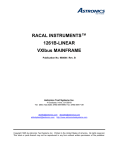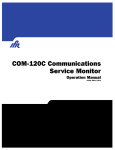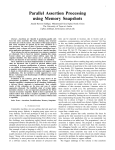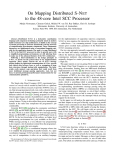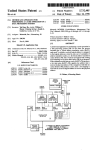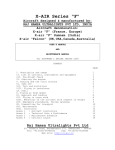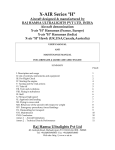Download 1\TCPIIP over AAL5
Transcript
US005717691A United States Patent [19] [11] Patent Number: Dighe et a1. [45] Date of Patent: [54] MULTIMEDIA NETWORK INTERFACE FOR ASYNCHRONOUS TRANSFER MODE COMMUNICATION SYSTEM 5,717,691 Feb. 10, 1998 OTHER PUBLICATIONS Stuart Wray et al. ‘The Medusa Applications Environment.” to appear in the Proc. of the Int'l. Conf. On Multimedia Computing and Systems. Boston. MA. May 1994. [75] Invent“: Joel E Adam a al. “A Network Architecture for Distributed Raychaudhu? ‘Princeton inaction an Multimedia Systems." in Proc. of IEEE 18th Annual Conf. of N J on Local Computer Networks. Minneapolis. MN. Sep. 1993. ’ ‘ ' ' pp. 70-76. 73 Assi nee: NEC USA Inc" Pri 06mm NJ. [ l g ’ n NEC MOS Integrated Circuit pPD98401 Local ATM SAR Chip-Preliminary Data Sheet. Jun. 1994. _ NEC nPD98402 Local ATM Sonet Framer User’s Manual. [21] Appl. No.. 550,330 [22] Film: Oct- 30’ 1995 [511 May 1996“ Primary Examiner-Douglas W. Olms Im. 01.6 ................................................... .. H04L 12/56 “Si-‘"1"’ ‘WWW-‘Ricky Q‘ Ng° [52] us. (:1. ......................... .. 370/401; 370/463; 370/466 “0'7"? 45'6"" 0’ Firm-“?ery 1' Bmscmer" Arthur 1' [581 Tm‘ghc“ Field of Search ................................... .. 370/389. 392. 370/395. 396. 397. 401. 463. 465. 466. 469' 474‘ 402 [57] ABSTRACT A multimedia communications and computer platform that 56 References C-ted can serve as a network interface card combined with an I l 1 U.S. PATENT DOCUMENTS . internal distribution network for a full range of user terrm'nal devices. It includes an interconnection network module that serves to route all incoming and outgoing information by 2:113:23; 5 594,732 “1997 Bell et all 5,617,539 way of high speed buses with value added features for 370/401 communication protocol acceleration. In particular. attached 4,1997 Ludwig a 3L ‘ 395/200”; to the di?‘erent ports of the network are an ATM module. a 5,623,495 4/1997 Eng et a]. .... .. 370/397 5,623,605 4/1997 Keshav et a]. ................... .. 395/20017 communications processor. a media processor and a variety of terminal devices. By migrating processing intensive func tions of network protocol termination. media stream distri bution and media stream adaptation into the network inter FOREIGN Pm DOCUMENTS 2267625 12/1993 2280338 1/1995 United Kingdom ........... .. H04N 7/14 United Kingdom . .. H04M 11/06 face card. there are avoided the bottlenecks of the traditional CPU centric approach to ATM systems. 9530318 9602099 WIPO .. H04Q 11/04 W[P0 .......................... .. H04L 12/56 11 Claims, 7 Drawing Sheets 11/1995 1/1996 2 22A 22B 120 . | ATM — — Video MPEG over AAL2 ATM VC ' I... 1 21 _ _ _ _ _ _ _ _ _ _ _| AUdlO over AAL1 AAL 21 "0 ENGINE \ 24 5 25\ 1* GP ROUTER A 25\ lLocal __ Memory ‘7°81 26/ 288 — — | | 21A PB CPU TCP/IP 23A — / 27 LMN A“d'° 280 MP Camera \ 29 28E Application 1\TCPIIP over AAL5 DATA VC Video go Display US. Patent Feb. 10, 1998 Sheet 1 of 7 5,717,691 10 12\\ / NETWORK CORE MCCP ATM ' / 14A PLAYOUT BUFFER 11 / 13 /’ GP INTERCONNECT NETWORK / 18 / FB \ / | \ MP 15 / HCPU ‘\ 14 AUDiO MPEG \ DISPLAY \ 17 16 FIG. 1 US. Patent Feb. 10, 1998 Sheet 2 of 7 5,717,691 E958 .GEw =83 E952 mm US. Patent Feb. 10, 1993 Sheet 5 of 7 5,717,691 1 O3 1 12 / 02 / / 1 15 r/w / CLOCK GENERATION 104 FOR SRTS 1 cell Buffer AAL-3I4 5 __, BUS ND BUS "F 1 14 AAL-i _ TX Englne Tx Engine E CNTL INFO 11o 0 ML u Tx Engine 105 E \ / STATE N 1 01 1 09 MEMORY 0 MM am?“ 106 IF Fix Engine E R AAL-3/4 107 Rx Engine / MAAL 108 1 13 Fix-Engine / I / EPROM ROUTER l/F ' 111 ct_l rqy indicator pins pms pms FIG. 5 US. Patent Feb. 10, 1998 5,717,691 Sheet 6 of 7 PSOS-M OPERATING SYSTEM ATM SERVICE MANAGER CALL PROCESSING 0.93 B OAM MESG SAAL CM MESG NMS ADMISSlON/RATE/CONGESTION CONTROL DYNAMIC UPC, ABR CONTROL ETC. TCP/IP MEMORY/BOARD MGT DEVICE DRIVERS FIG. 6 MTP IPC US. Patent Feb. 10, 1998 Sheet 7 of 7 /74 / 7s 4 MBTYPE sRAM PROGRAMMABLE TIMERS 72 i-960 CF 5,717,691 /70 UART /81 ROUTER CONTROL \73 BLOCK 256 KB FLASH MEMORY \ 77 \ 75 FIG. 7 5,717,691 2 1 All existing media devices can be plugged into this card without any modi?cations. Multitasking is inherent to multimedia so the card has to support concurrent media sessions with little MULTIMEDIA NETWORK INTERFACE FOR ASYNCHRONOUS TRANSFER MODE COMMUNICATION SYSTEM throughput degradations. FIELD OF THE INVENTION Interoperability with PCs and Workstations using legacy This invention is related to multimedia communication Operating Systems. systems based on Asynchronous Transfer Mode (ATM) network technology, and more particularly to network inter face apparatus for use at subscriber premises in such sys Intelligent networking and media-related features that 10 tems. allow off-loading functions from both the host CPU as well as the network central ot?ce. Ability to operate in a stand-alone mode without a host CPU. The present invention. to be termed the Multimedia BACKGROUND OF THE INVENTION Conventional network interface cards (NICs) for use with Computer and Communications Platform (MCCP). plays the ?rst generation ATM networks have performance and func tionality restrictions. These conventional NICs typically consist of ATM segmentation and reassembly (SAR) hard ware along with input/output (110) control logic for attach role of an intelligent network interface card for running multimedia applications on existing workstations. PCs and even residential set-top boxes. The prototype architecture supports a wide range of network-edge products. such as a simple Video On Demand receiver. an advanced multimedia ment to the data bus of user terminal devices. such as personal computers or workstations. In this approach. all workstation. and a small-scale video server. communications and media stream handling functions are The MCCP is designed speci?cally to handle multimedia tra?ic at the subscriber premises. This relieves the host CPU cally via driver software embedded in the terminal’s oper from high-speed network and media stream related ating system (OS). While this NIC architecture was satis functions. and at the same time facilitates modular addition factory for earlier generations of networks (such as 25 of media processing and display devices to the user terminal Ethernet). severe performance bottlenecks are experienced arrangement. The MCCP may thus be viewed as a “network when it is applied to ATM networks that can deliver up to centric” architectural approach as opposed to the “CPU 155 Mbps to the user terminal device. This is because the centric” approach traditionally used in current systems. performed under central processor unit (CPU) control. typi— CPU is required to perform a variety of high-speed network protocol. data movement and media stream adaptation functions. thus resulting in a processing limited system Others have recognized the shortcomings of this CPU centric approach and sought approaches to relieve the load on the CPU. One approach proposed by Stuart Wray et al in a paper entitled ‘The Medusa Applications Environment” (in Proc. of Int'l Conf. on Multimedia Computing and The MCCP generally includes: 1. An ATM module that terminates ATM and performs all the ATM functions. This includes AAL support for AAL-1. AAL 3/4. AAL 5 and a new AAL cell-rate shaping and scheduling for multiple traf?c classes. 35 Systems. Boston. Mass.. May 1994) is a fully distributed checks for validity. does the adaptation layer system in which the ATM network itself is used to inter connect various media processing and PC/workstation mod ules that comprise the user terminal. The interface card processing. and then passes it to a core interconnection network for routing to the various local devices. 2. A Communications processor (CP) module that termi nates all the networking functions. such as signaling. transport processing. memory management of the core. network management and control. The CP is expected design adopted by Wray et al does incorporate a CPU for processing. but does not provide the media switching and adaptation capabilities. Another approach is represented by the VUNET system described by J. F. Adam et al in a papm' entitled "Experience with VuNet: A Network Architecture for Distributed Multimedia Systems" (in Proc. of IEEE 18th Annual Conf. on Local Computer Networks. Minneapolis. September 1993. pp. 70-76) in which the interface card incorporates functions required to terminate video applica tions. This system does incorporate some media-related processing into the NIC. but does not provide the more 45 (APIs) on various local terminal devices as well as the 50 via a novel distributed functional architecture that is better matched to the full needs of multimedia applications. SUNIMARY OF THE INVENTION This invention avoids the traditional CPU bottleneck by migrating processing intensive functions of network proto col termination. media stream distribution/switching, and 3. A Media Processor (MP) module that serves as the interface between streams-oriented data and the net work. This includes playout strategies as well as con cealment and reconstruction strategies for different media devices. It may also interact with the CF to There accordingly remains a need for a communication ated with the traditional AI'M Network Interface Unit (NIU) to interact with Applications Programming Interfaces ATM network to negotiate and renegotiate resources and similar housekeeping functions. general multiple media handling. switching and processing. platform that overcomes the performance problems associ The ATM module takes data from various local devices and puts out valid ATM cells to the network and conversely receives ATM cells from the network. ensure that the correct bandwidths are allocated for the 55 ditferent streams and renegotiate if its playout buffers (on a per stream basis) start ?lling up or emptying too soon. 4. A special-purpose network interconnect module. termed the router. that allows various local devices to be attached to the MCCP by high speed buses and provides for full non-blocking connectivity from any port to another. The interconnect fabric also provides some enhanced processing. such as data acceleration. media stream adaptation into a novel network interface card. for certain data protocols. The main architectural goals that drive this invention are as 65 In our illustrative embodiment. the invention advanta follows: geously further includes an arrangement for the intercon nection network module that allows for a self-con?guring Plug and Play Multimedia 5.717.691 3 4 interface. This is achieved by its having an internal switch ing core that is independent of edge local terminal devices and Bus Interface units that can be reprogrammed to speci?c BRIEF DESCRIPTION OF THE DRAWING FIG. 1 shows the basic structure of the MCCP in accor dance with the invention connected to various multimedia local devices by implementing them with Field Program devices; mable Gate Arrays (FPGAs) or other suitable reprogram mable devices. Our illustrative embodiment also includes subsidiary fea tures such as an ATM Adaptation Layer (AAL) engine that FIG. 2 illustrates schematically the functional architecture of the MCCP and its relation to associated local terminal devices in a system in accordance with the invention; FIG. 3 shows in block functional form the elements of the allows the user to choose from a multitude of AALs and involves a design that allows complete ?exibility in mapping an AAL to a speci?c Virtual Circuit (V C) as well as scalability in terms of the number of VCs the card can 10 router included in FIG. 2.. FIG. 4 shows the functional architecture of the bus support. The AAL engine also has built-in hardware support interface (BI) units of the kind included in FIG. 3. for higher level functions. such as video concealment and counters for rate and ?ow control at the higher layers. Another subsidiary feature of the illustrative embodiment is a Bus Interface (BI) unit that is ?exible in terms of engine of the kind used in the MCCP of FIG. 2. FIG. 6 shows the main functions of the Communication FIG. 5 shows the functional architecture of an AAL Processor. FIG. 7 shows the hardware architecture that can be used allowing multiple asynchronous buses to be interconnected in the MCCP along with providing hardware assistance for for the Communication Processor and the Media Processor. enhanced Communication Protocol Processing. such as data integrity support (checksum or CRC). 20 The architecture of our novel MCCP is based on the recognition that high-speed network interface functions are central to a new network-based multimedia computer/ terminal (in the same way as the CPU currently forms the core of a conventional computer). This motivates develop ment of a multipurpose and high-performance network 25 interface card that can serve as the core of the future ATM terminal. In contrast to existing ATM host interface card architectures that rely on the host CPU for many commu nication functions. the MCCP concept aims to handle all 30 networking-related tasks and pass application-level data 35 switching capabilities for routing control information. data packets and media streams to their respective processing or 40 memory element. Essentially. the hardware design of the invention provides. in an illustrative embodiment, a distributed approach in which a high capacity router connects the ATM interface module to various communications processing and With reference now to the drawing. FIG. 1. which is illustrative of the invention. shows the basic functional modules of the MCCP 10 together with a variety of common terminal devices connected thereto. The basic components of the MCCP are the local interconnection network module 11. to be termed the router. the ATM module 12 that interfaces with the ATM network. the communications pro cessor module (CP) 13 that manages the various networking functions. and the media processor module (MP) 14 and its associated playout buffer 14A. Also. various user-premises only to media processing devices via a shared memory interface. In this way. application devices and software can be developed with a uniform “local processing” paradigm independent of network speci?c interfaces (which are often subject to change). Recognizing also that future ATM ter minals will generally involve a multiplicity of media pro cessing and display devices. the MCCP incorporates local DETAILED DESCRIPTION OF THE INVENTION 45 media/data processing modules including advantageously an AAL engine. a communications processor (CP). a media processor (MP). a media playout buffer. a host CPU bus devices. such as a host CPU 15. an MPEG (Motion Picture Export Group) encoder 16. an audio device 17. and a video display 18 with its frame buffer 18. would be coupled to the interconnection network. In FIG. 2. there is shown in greater detail the basic architecture of a typical MCCP connected to various mul timedia devices in accordance with the invention. A router 21 serves as the network interconnection module for routing signals between the various modules. More detail of the router 21 will be discussed with reference to FIG. 3. The ATM module 22 is the interface that takes outgoing data from the various terminal devices and transmits it as valid ATM cells to the ATM network It also receives incoming ATM cells from the networks. checks these for validity and does the adaptation layer processing. Functions that this module needs to perform are the usual expected of connected various media devices. IncomingATM signals are 50 such an interface and include ATM segmentation and interface and a local multimedia network to which are reassembly. error checking. cell rate shaping. cell level scheduling. and direct memory access (DMA) to and from various devices. ?rst processed in the ATM module and then routed to the communications processing module. During the processing in the ATM. a virtual circuit is established at the ATM level The ATM module 22 typically includes a chipset includ after which the communications processor handles local control functions within the media processor to set up an 55 ing one chip 22A (AIM SAR) to do the segmentation and reassembly (SAR) and another chip 22B (ATM PHY) to do the physical level functions (PHY). Typical chips for these appropriate path for the assigned VC through the router to the host CPU in the case of data and to the media devices in the case of media signals. The CP also marshals appropriate roles include NECEL pP D9840l for the SAR chip and NECEL pP B98402 for the PHY chip. However. the typical protocol and media processing resources available in the form of the AAL engine and the MP adaptations. In general. an ATM multimedia session will involve multiple virtual circuits containing video. audio and data so that the MCCP ATM SAR chip only supports ATM Adapation Layer (AAL) 5 which is optimized for data transport. In multimedia it is desirable to include multiple AALs. and accordingly advan tageously the rest of the AALs desired are implemented on a separate AAL engine chip 24 that is coupled between the is required to provide multitasking support through each of the major hardware units mentioned above. The invention will be better understood from the follow ing more detailed description taken in conjunction with the accompanying drawing. 65 router 21 and the ATM SAR 22A. One of the novel features of our approach is the inclusion of a multimedia AAL. The video AAL advantageously sits 5,717,691 5 6 under a more generic transport protocol for multimedia called the Multimedia Transport Protocol (MTP). One of the fundamental assumptions behind the MTP is that for some media data. such as video or voice, corrupted data. or blocks of data with gaps in them. is not necessarily data that needs which is controlled by the MP 27. Playout strategies are guided by the device requirements and the worst-case cell delay variation seen in the network. Since some of this is not known a the MP should be able to change the to be thrown away and that proper reconstruction or con perform is synchronization of multimedia data and conceal strategies ?exibly. The other functions that the MP can cealment strategies can restore the original data without ment strategies for display. The MP also needs to interact having to retransmit. The AAL engine 24 desirably also provides hardware support for the concealment strategies with the CF to ensure that the correct bandwidths are such as deducing the length of a gap in transmission and putting the data in its appropriate address by taking the size 10 of the gap into account. As will be discussed in more detail later. with reference to FIG. 5. a novel feature of the AAL engine is the use of state memory to maintain AAL states for receiver-transmitter (UART) 70 for the conversion of par allel to serial and serial to parallel data for use by the various virtual circuits (VC). This essentially allows for a scalable solution. as the number of VCs that the AAL engine can support is only determined by the amount of address lines on the state memory. Adding the number of VCs in this solution involves adding more memory onto the board. Details of a suitable AAL engine will be described in connection with FIG. 5. associated processor. Each further includes a local bus 72 from the router 81 that is adapted to the i-960CF processor chip 73 together with the 4 megabyte SRAM 74 that serves as the playout buffer in the MP version and as the main 20 memory for the CP version. A control block 75 serves to orchestrate control across the local bus and programmable timers 76 serve as the timing counters for the data. Each one The communications processor (CP) 25 with its associ ated local memory 25A handles all the network related functions as well as the overall management of the MCCP. The CP advantageously serves to o?load transport protocols from the host CPU 26. such as TCP/IP or IDP/IP. Some of allocated for the streams. The CP may need to renegotiate if the MP ?nds its transmit buffers ?lling up too often or ask for a throttle if its receive butters start ?lling up too soon. The basic hardware architecture of both the CP and MP is shown in FIG. 7. Each includes a universal asynchronous 25 the functions typically performed by the CP include call setup signaling and all the necessary functions to load state memory needed for the ATM function as well as the man agement of data movement from the network to the devices 30 and vice versa. The CP also advantageously sets the knobs for the ATM module so that it can do the ?ne-grained scheduling of cells for multiple tra?ic classes. The CP also also has a 256 kilobyte ?ash memory 77 for nonvolotile storage of programs and data. Returning to FIG. 2. the router 21 is provided with an additional port that includes the S-BUS 21A that leads to the host CPU 26. which for example might be :1 SPARC workstation. The most important module of the MCCP for the desired operation of the MCCP is the interconnection network module that essentially comprises the router 21. The desire to make things simple to the user. or premises. terminal devices requires an intelligent interconnection network. If interacts with the APIs on various devices to renegotiate latency in transferring data from one device to another is resources if need be. FIG. 6 is a software stack showing the 35 critical. then the interconnection network needs to operate in various roles the communications processor advantageously should provide. Typically. the CP can be an Intel i-960CF processor with four megabytes of local memory using the a cut-through fashion with burst-dma operations. It also needs to be a multi-protocol multi-bus device that can interact with various bus protocols and arbitrate requests and grants in a fair fashion. One desirable objective for the PSOS-M operating system. The media processor (MP) 27 is designed to permit all MCCP for the future is that it should be a Universal Port. In the Universal Port concept, there is no attempt at precon ?guring the devices that will attach to the network interface card but allows the card to ?gure out what is attached to it. well-known standard media devices. such as video coders using MPEG/JPEG or NTSC formats and audio coder using PCM, to plug into the MCCP with little modi?cation. To this end. desirably the MP utilizes a local multimedia network (LMN) 28 that supplies various multimedia terminal This allows one to plug in a phone. a PC or aTV to the same devices. such as an MPEG terminal 28A. an audio device 2813. a camera 28C and a frame butfer 28D with its video port. However. the lack of a common physical medium standard for these devices presently prohibits such a uni versal device (wireless is being viewed as a possible can display 28E. Moreover. problems that stem from transport didatc however). In the MCCP. we attack the problem by ing these signals over an ATM network should be hidden from these devices. The MCCP has to smooth out the jitter 50 noting that even though it will be necessary to have different interfaces to the di?erent devices. the main core of the than inevitably arises in the cell-based asynchronous nature interconnect network should be device independent. This of the stream and the media processor needs to serve this role and to this end includes a playout bu?’er 29. leads to an interconnection network. or router. in which at its edges there are interfaces that are speci?c to each device to be attached thereto and in the center there is a core switching Intel i-960CF processor with 4 megabytes of memory which 55 fabric that is universal. Moreover. the MCCP can be made to be essentially self-con?guring by implementing the inter can be used for the playout bu?er 29. At setup the MP is The media processor 27 also advantageously can be an way of each port on the LMN by way of a peripheral face speci?c logic of the router 21 in Field-Programmable Gate Arrays (FPGAs). in which case adding a speci?c component interface bus (PCI). interface or replacing one with the other is as simple as programmed to playout to the various multimedia devices by The MP 27 can be programmed to synchronize and orchestrate the multimedia data and to provide some con cealment support for standard codes. The MP advanta geously also runs PSOS-M so it can share functions with the CP 25 when needed. The MP also avails itself of clock recovm'y support from the AAL engine 24 for playing out AAL-1 tra?ic. The MP advantageously uses the large play out butter 29 to ensure that it can play the data out at a rate retargeting the FPGA. This is equivalent to doing another compile of software. There may remain mechanical issues that should be within the skill of a worker in the art but the ability to retarget the FPGAs and the ability to swap pins to signals are very powerful mechanisms for approaching this 65 notion of a Universal Port As shown in FIG. 3. the router 21 consists of 5 functional modules: one central DEMUX (Demultiplexer/Multiplexer) 5,717,691 7 8 module 31 that performs switching between the buses and four separate BI (Bus Interface) units 32-35 that perform and appropriately delivering these two types of information on destination buses. bus protocol conversion (bridging), arbitration. buffering. and on-the-?y communication protocol speci?c data pro The router arbitrates transfer requests for target buses between local units on the bus and other buses intercon FPGA appropriately programmed. nected by the router. Once the particular request is granted. the router follows the transaction through till the completion Solid lines 36 between the BI modules 32. 33. 34 and 35 and DEMUX module 31 represent data/address lines (multiplexed) for encoded information for the selection of the switching path and for the signals for control of data and address transfer between BI units. Dashed lines 37 represent transfer request and grant lines between BI units and preemptive. The transactions between the buses can be single 32-bit word or bursts of up to 16 words. The basic structure of a Bus Interface (BI) unit 40 included in the router in accordance with an illustrative embodiment is shown in FIG. 4. Not shown are the various cessing. Basically. the hardware of each BI would be a of the bus transfer. i.e. the router transactions are non between the DEMUX module 31 and the BI modules 32-35. DEMUX block 31 is advantageously a combinatorial processing modules and input/output terminal devices that four-port switching matrix. Each port con?guration is con granted. of data being supplied to the unit or the source of data being supplied from the unit. Also not shown are the various external memories that may be associated with the BI and that would be accessed via the various butfers included in the BI. The local bus 41 and the remote or demux bus 42 that connects to the DEMUX unit 31 of FIG. 3 each comprise a data line and a control line. the data lines are the solid lines and the control lines are the dashed lines. shown by lines 41A. 41B and 42A and 42B. respectively. The BI includes a control logic unit 44 that receives the control signals from the local and remote bus conu'ol lines 41B and 42B and distributes them appropriately. The BI also includes an internal bus 45 that receives data signals from the buses and Essentially, the router comprises an interconnection media for high speed buses with value added features for communication protocol acceleration. Each bus has its com Various other units are typically included within the BL The local bus master controller (LBMC) 47 uses control are attached to the local bus 41 that are either the destination trolled by three select bits which determine to which other port it will be connected. and what is the direction of transfer. These bits are driven by the BI module attached to the particular port of DEMUX. There is no possibility of con?icting assignments since the source BI port assigns active value to the select bits only after its request has been granted by destination. and the arbiter at the destination 20 grants only one access at the time. Deadlock free arbitration at BI is achieved by assigning ?xed priorities to requests from other BE. and always backing olf the request from the 25 local bus of a BI if a remote request has already been distributes them appropriately. munication protocol and clock speed independent of other signals supplied from the control logic unit 44 to control buses. Each bus can run at the clock speed up to 33 MHz. which of the modules or terminal devices attached to the local bus is allowed to connect thereto. The local bus slave The router performs protocol and speed conversion between buses. and connects them in a non-blocking crossbar man 35 controller (LBSC) unit 48 interprets the local bus cycles and ner. The arbitration between multiple requests is performed generates at appropriate times the request for connection of in a distributed manner. i.e. each destination port has an the data line of the local bus to the data line of the remote bus. The Demux port slave controller (DPSC) 50 acts to control the transfer of data tolfrom other Bus Interface units when the instant BI is acting as the source of the transaction. The Demux port master controller (DPMC) 51 acts to control the transfer of data tolfrom other BIs when the instant BI is acting as the destination of the transaction. Also included are write bu?’ers (WB) of which two 51A and 51B are shown for the temporary storage of data 45 independent arbiter which resolves requests for itself regard less of the requests for other ports of the router. Deadlock free arbitration is achieved by assigning ?xed priorities to requests from other. and allows backing oil‘ the request from local bus if remote request has already been granted. The backoff is a mechanism built into bus protocol that enables suspension of bus transfer that has already been started. In the router design it is a necessary feature of local buses interconnected by the router. since if two agents on two di?’erent buses attached to the router start a transaction by supplied by the local data bus line for transfer to the remote bus. Also included is a remote request generator (RG) 53 that generates a transfer request in connection with the transfer of data from a device attached to the instant B1 unit asking for access to each other. they would wait inde?nitely for each other by holding its own local bus and waiting for the other to release the local bus (thus resulting in deadlock). connected to the Demux to another BI unit connected to the DEMUX. Also included is the remote request arbiter RA 54 unless there is a backo?’ mechanism. All four buses attached to the router of the MCCP have this backo? feature. The that arbitrates requests from other BI units interfaced. Additionally, the Demux Write Bu?er 55 and the Demux Read Bu?‘er 56 are included for the temporary storage of router can also perform data touching on-the-?y processing of communication PDUs (Protocol Data Units) transferred between the buses and store the results in accumulators. Each one of the buses connected to the DEMUX can perform read or write access to any other destination bus. 55 data from or for the DEMUX data bus 42A when the data bus 71A has stringent timing requirements that make such temporary storage desirable. Additionally. the BI that is attached to the communica tions processor CP of the MCCP that executes transport protocol processing for the MCCP would include a commu nication protocol accelerator CPA 60 that includes an arith be performed concurrently due to the crossbar non-blocking metic logic unit (ALU) 61 and four accumulators 62 to interconnection structure. The path selection is performed perform data touching on-the-?y so that checksum calcula by address decoding. Each source assigns a portion of its tions can be performed for up to four protocol data units address space to each one of its destinations. The interconnected buses may have multiplexed or 65 within the same time period. Each BI unit is run at the speed of the bus to which it is demultiplexed data and address. The router is responsible for interfaced and the communication between each BI and the interpreting address and data information of the source bus The two agents involved in a data transfer through the DEMUX are the source bus and the destination bus. The source bus initiates operation. Non-con?icting accesses can 5,717,691 10 9 port of the router to which it is connected is performed in an number and a one bit start of a PDU indicator. The MT? asynchronous two-way handshaking manner. thus making module in the CP will take action in the event of lost cells (concealment for example). the clock rates of the interconnected buses independent of one another. Returning now to FIG. 2. as previously mentioned. since the pPD 93401 in the ATM SAR 22A used in the illustrative 5 include a bus interface unit 101 that snoops on the bus embodiment only provides segmentation and reassembly for the AAL-5 protocol and since it is felt that most multimedia workstations will need separate AALs for each of different media types. a separate AAL engine was designed to provide segmentation and reassembly for the non-AAL 5 traffic. It The functional architecture of the AAL engine 25 is shown in FIG. 5. The main components of the engine 10 between the router and the ATM SAR chip. a sequencer unit 102 that serves to control and schedule the transmission of data ?ow into and out of the engine. Three sets of engine units are included. one for the AAL 1 (103.106) protocol. one for the AAL 3/4 (104.107) protocol. and a third MAAL was also felt that one of the most important AALs for (105.108) for the future AAL2 (or video) protocol. for each multimedia is still unde?ned: namely the video AAL. of the transmit and receive functions. An SRAM 109 that The architecture of the AAL engine 25 as shown in FIG. 5 was guided by the following requirements: Scalability: the number of VCs it could support could be modularly increased and the design should scale to many thousand VCs. Flexibility: the VCs could ?exibly share the AALs with 15 control signals from the router and returning ready and indicator signals to the router. A one cell buffer 112 is interposed between the bus interface unit and the sequencer 20 out any constraints so all VCs may use the same AAL for temporary storage. EPROM 113 is coupled to state memory 110 to serve as at any given time if the need arose. Performance: The AAL Engine could snoop at the bus between the ATM chip and the router to augment the additional AAL functions without degrading the per serves as the state memory is coupled to the sequencer by way of the state memory interface unit 110. It further includes a router interface unit 111 for receiving various 25 a table lookup for video concealment support of the multi media AALs 105. 108. A synchronous residual time stamp clock recovery circuit 114 is included coupled to AAL-1 engine as is customary. In the transmit direction. the typical data ?ow is as follows: The ATM SAR chip signals to the router indicating formance of the AAL 5 traffic. The AAL Engine architecture is based on the fact that memory access times on SRAMs (15-20 us) are typically that it needs to transmit a cell. The router signals to the AAL much faster than the transmission time of an ATM cell (a few engine that the transmitted cell needs AAL Engine process microseconds), so a judicious use of state memory to store 30 ing by using a code word on the ct! pins of the router the state of a VC and specialized state-machines for each interface unit 111. The AAL Engine then goes and grabs data AAL type to process and update the state information on a from the bus (the router puts up information about the AAL cell by cell basis promises scalability without any through put degradation. TheAAL engine has to process a cell within one cell transmission time. This requirement translates to giving the AAL Engine 1.4 microseconds to ?nish its AAL processing before the next cell (2.83 microsecond in both transmit and receive directions). However. the bus is oper ating at 1 Gb/s (30 ns cycle time). so even in the worst case. if we buffer up one cell into the AAL engine at the 1 Gb/s rate and deliver it to the pPD98401 or the router a few cycles after that. We should be able to keep the pipe full in both the directions as far as the ATM PHY chip is concerned. Initial simulation results show a worst case delay of about 3 cycles for processing the AAL data (which is 90 ns) so the requirements will be easily met. In other words. the number of VCs supported is limited by the address lines on the SRAM that can be supported on the board and not by any throughput limitation. The AAL Engine is fully able to type and the channel number) of an appropriate virtual 35 channel in the state memory 109. It also latches the infor mation about the nature of the transfer by looking at the rlw pin on the bus interface 101 from the ATM SAR chip (r=Tx and w=Rx). The sequencer will then signal rdy to the router telling it to start transmission by way of the router interface 111. The sequencer will then go to state memory 109 and get the state information on that channel. The AAL Engine bus interface 101 then will grab data on the bus one word at a 45 time and store it in the one-cell bu?’er. It will signal rdy to the router when it wants the next word. By the time the entire cell is stored in the buffer (47 or 44 raw data bytes) the relevant AAL Tx engine (AAL 1,2 or 314) will have com puted the header for transmission. The AAL Engine will store raw bytes into the one cell buffer taking into account the byte alignment of the present transfers. Though the router will transmit on word boundaries the AAL engine will process as many VCs as needed as it is only processing one 50 re-align the data before n'ansmitting it to the AIM SAR chip. cell at a time and ?nishes its processing before the next cell The information on how AAL 1 and AAL 3/4 headers are arrives. The initial set of AALs that are implemented on the engine in the preferred embodiment of the invention are: computed is available in the ITU document I135 and will not be described here. AALZ processing consists of a sequence number update (N —>N+1)and a start of TPDU bit l. AAL-1 for CBR tra?ic. Details of this AAL are 55 (1=start. 0=continuation). Now the AAL engine will append described in I. 135 document from ITU. the AAL header and transmit it to the ATM SAR chip. It does 2. AAL 3/4 for Connectionless and Connection Oriented Data trai?c. This AAL is useful for Internetworking or Router Applications and is also described in 1.135 document from ITU. 3. Multimedia AAL (MAAL) for multimedia stream ori ented traf?c. This is a subset of the Multimedia Trans this by putting the relevant ATM cell on the data bus one word at a time and signaling to the router which then signals to the ATM SAR chip to accept the data. In the receive direction. the same operation is repeated The AAL engine will store an entire cell from the ATM SAR chip on its on-chip buffer memory. get state information port Protocol (MTP). Its a very simple AAL which based on the channel number that the ATM chip passes down on its A/D bus of bus interface 101 and the AAL type (which consists of a sequence number in the transmit direction and an ability to detect cell losses in the receive 65 is sent by the ATM SAR chip when it ?rst sends a request to the router and the router noti?es the AAL engine to grab direction. Each 47 bytes of raw data has a one byte the AAL value). It then processes the AAL header on the cell header. The header consists of a seven bit sequence 5.717.691 12 11 It is to be understood that the speci?c forms of the various for valid reception. When the router asks for the data. the modules described are merely illustrative and that various AAL engine will send an indication down to the router if the modi?cations thereof can be made within the spirit and cell was received correctly or incorrectly using the indicator scope of the invention. In particular. the router can be used pin on the router interface 111. If the cell was received incorrectly the AAL engine will also interrupt the CF to 5 to interconnect any desired number of ports. for example a come and check the error registers using the indicator pin. separate port for each of a variety of terminal devices. The type of error and when the CP should be interrupted is What is claimed is: all masked so the AAL engine does not interrupt the C? on 1. A multimedia communications platform for location at the reception of all errored cells but only a setable few. Also a user premise to interconnect terminal devices with an ATM for AAL2. concealment support is provided. If a cell is network comprising: received and there has been a gap in reception. the AAL means for providing an ATM interface with an ATM engine will provide the correct address to write the cell into network; physical memory by using an EPROM 113. The EPROM 113 is basically a table look up that gives a multiply by 47 operation. The router will always ask for the correct address to write the data into/from the AAL Engine ?rst before 15 requesting the data. One of the novel features of this engine is the implemen means for serving as an interface between media signals and media terminal devices; tation of an AAL 105.108 suitable for Video Tra?ic. The video AAL sits under a more generic transport protocol for and means for forming an interconnection network and multimedia called the Multimedia Transport Protocol (MI'P). One of the fundamental assumptions behind the routing incoming and outgoing information signals MTP is that for some media data. such as video or voice. corrupted data or blocks of data with gaps in them is not necessarily data that needs to be thrown away and proper reconstruction or concealment strategies can restore the 25 original data without having to retransmit. The AAL engine provides hardware support for the concealment strategies by deducing the length of a gap in transmission by looking at the sequence numbers of the incoming cells on a per VC basis. and then going to EPROM 113 to compute the new address that the data should be put in (if the gap is N cells and if the last cell was placed in memory location A then the new location of memory is A+N*47). This enables the media processor to play the data out without having to rearrange between each of said earlier-mentioned means by way of high speed buses with added features for commu nication protocol acceleration wherein said means for forming the interconnection network includes a core means for switching and a plurality of separate bus interface means for performing bus protocol conver sion and said bus interface means further comprises a 30 ?eld programmable gate array that can be implemented to provide a preselected logic interface. 2. A multimedia communications platform in accordance with claim 1 further comprising: means for concealing corrupt data received from the ATM the cells in memory—-which is always a slow time consuming process. means for providing network related functions and overall management of the platform wherein said means for providing network-related functions further serves to oflload transport protocols from a host CPU; 3 By way of summing up the invention provides a multi media computer and communications platform in which a high-capacity “router" connects the ATM interface circuit to various communications processing and media/data process ing modules. including: an AAL engine. a communications processor (CP). a media processor (MP). a media playout butfer. a host bus interface and a local multimedia network with connected media devices. An ATM virtual circuit (VC) is established within the platform via signaling messages which are ?rst processed by the ATM PHY/SAR interface 45 and then routed to the CP via the router. Once the VC is network. 3. A multimedia communications platform in accordance with claim 9 further comprising: means for storing the data received from the ATM net work; means for determining a position within the storage means that the data received from the ATM network is to be stored; and wherein said concealing means orders the data received from the ATM network within the storage means as if no corruption of the data took place and preserves a correct order of the data. 4. A multimedia communications platform in accordance with claim 3 wherein said determining means includes an established at the ATM level. the CP also handles local Electrically Programmable Read Only Memory (EPROM) control functions within the MPto set up an appropriate path that contains a table of addresses. for the VC through the interconnect network to either host 5. A multimedia communications apparatus in accordance CPU or media devices. It also marshals appropriate protocol 5O with claim 3 including: and media processing resources available in the form of an Electrically Programmable Read Only Memory AAL engines and MP adaptations. For example. an MPEG (EPROM), connected to said concealing means. and video VC would be routed through an AALl. 2 or 5 engine containing a table of addresses and wherein said con and then into a playout buffer controlled by the MP and cealing module. upon receipt of data received from the ?nally into an MPEG decoder connected to the local mul ATM network. examines the table of addresses and timedia network (LMN) as indicated by the path 120 in FIG. determines where said received data is to be stored 2. In a similar manner. an audio VC would be routed through within a memory such that the received data is stored an AALl engine. into a playout bu?’er controlled by MP. and through the LMN into an audio encoder/decoder as indicated by path 121 in FIG. 2. In contrast. a TCPIIP packet data VC would be routed through an AALS engine into the host CPU 26 connected through the host bus interface as shown by line 122 in FIG. 2. Note that. in general. an ATM multimedia session will involve multiple VCs containing video. audio. data. etc.. so that the MCCP is required to provide multi tasking support through each of the major resources outlined in FIG. 2. in the memory as if no corruption took place and a correct order of the data is preserved 6. A multimedia communications platform for location at a user premise to interconnect terminal devices with an ATM network comprising: means for providing an ATM interface with an ATM network; means for providing network related functions and overall management of the platform wherein said means for 5,717,691 14 13 a means for storing the data received from the ATM providing network-related functions further serves to network; o?load transport protocols from a host CPU; a means for determining a position within the storage means that the data received from the ATM network is to be stored; and wherein said concealing means orders the data received from the ATM network within the storage means as if no corruption of the data took place and preserves a correct order of the data. means for serving as an interface between media signals and media terminal devices; and means for forming an interconnection network and routing incoming and outgoing information signals between each of said earlier-mentioned means by way of high speed buses with added features for commu nication protocol acceleration wherein said means for forming the interconnection network includes a core means for switching and a plurality of separate bus interface means for performing bus protocol conver sion and said bus interface means further comprises programmable logic which can be implemented to provide a preselected logic interface. ‘7. A multimedia communications platform in accordance 10 Electrically Programmable Read Only Memory (EPROM) that contains a table of addresses. 15 with claim 6 wherein each of the bus interface means further comprises a ?eld-programmable gate array that can be implemented to provide a preselected logic interface. 8. A multimedia communications platform in accordance with claim 6 further comprising: a means for concealing corrupt data received from the ATM network. 9. A multimedia communications platform in accordance with claim 6 further comprising: 10. A multimedia communications platform in accordance with claim 9 wherein said determining means includes an 20 11. A multimedia communications platform in accordance with claim 8 further comprising: an Electrically Programmable Read Only Memory (EPROM). connected to said concealing means. and containing a table of addresses wherein said concealing means. upon receipt of data received from the AIM network. examines the table of addresses and deter mines where said received data is to be stored within a memory such that the received data is stored in the memory as if no corruption took place and a correct order of the data is preserved. *****
















